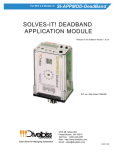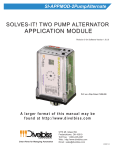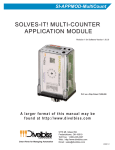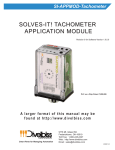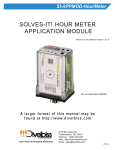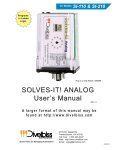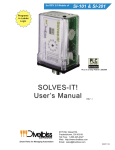Download - Divelbiss Corporation
Transcript
SI-APPMOD-DeadBand SOLVES-IT! DEADBAND APPLICATION MODULE Revision 0 for Software Version 1.0.0.0 PLC on a Chip Patent 7,299,099 A larger format of this manual may be found at http://www.divelbiss.com Smart Parts for Managing Automation 9778 Mt. Gilead Rd. Fredericktown, OH 43019 Toll Free: 1-800-245-2327 Web: http://www.divelbiss.com Email: [email protected] 2008010.0 Table of Contents TABLE OF CONTENTS Table of Contents Package Contents Page 1 Page 1 Getting Started How to Use this Manual Page 2 Page 2 SI-APPMOD-Deadband Basics Get to Know the Module Module Mounting Module Input Power Module Operation User Interface Analog Input Signal Connections Output Connections Tuning the Module Expandability / Customization Programmed from Factory Specifications Page Page Page Page Page Page Page Page Page Page Page 3 3 4 4 5 5 6 6 7 8 8 WARNING! The SI-APPMOD-DEADBAND, as with programmable controllers, must not be used alone in applications which would be hazardous to personnel in the event of failure of this device. Precautions must be taken by the user to provide mechanical and/or electrical safeguards external to this device. This device is NOT APPROVED for domestic or human medical use. PACKAGE CONTENTS Whats Included Qty 1 1 1 6 Description Part Number Location SI-210 with Software Pre-loaded SI-APPMOD-DEADBAND Manual Din-rail Socket Commutating Diodes SI-210 2008010.X 115-105328 111-101012 In In In In SI-APPMOD-DeadBand User Manual Document #: 2008010.0.pdf Box Box Box Box Page 1 of 8 Divelbiss Corporation 9778 Mt. Gilead Rd. Fredericktown, Ohio 43019 1-800-245-2327 www.divelbiss.com GETTING STARTED This section explains how to read this manual and understand the symbols. HOW TO USE THIS MANUAL In this manual, the following conventions are used to distinguish elements of text: BOLD Denotes labeling, commands, and literal portions of syntax that must appear exactly as shown. italic Used for variables and placeholders that represent the type of text to be entered by the user. SMALL CAPS Used to show key sequences or actual buttons, such as the OK button. OK, where the user clicks In addition, the following symbols appear periodically in the left margin to call the readers attention to specific details in the text: Warns the reader of a potential danger or hazard that is associated with certain actions. Appears when the text contains a tip that is especially helpful. Indicates that the text contains information to which the reader should pay particularly close attention. All Information and Specifications Subject to Change without Notice SI-APPMOD-DeadBand User Manual Document #: 2008010.0.pdf Page 2 of 8 Divelbiss Corporation 9778 Mt. Gilead Rd. Fredericktown, Ohio 43019 1-800-245-2327 www.divelbiss.com MODULE BASICS This section describes the SI-APPMOD-DeadBand Application Module including input/output assignments and an operational description. GETTING TO KNOW THE MODULE The module is connected to external devices via its included mounting socket. Connector Pin out Bottom View (Solves-It! Connector) Pin Pin Pin Pin Pin Pin Pin Pin Pin Pin Pin 1 2 3 4 5 6 7 8 9 10 11 Below Deadband Output Not Used - GPIO3 / HSC Not Used - GPO4 Not Used - GPO5 - Analog Input Signal + Analog Input Signal Earth Gnd Input Power Common 10-32VDC Input Power Above Deadband Output In-Deadband Output Figure 2.1 - Module Pin-Out SI-APPMOD-DeadBand User Manual Document #: 2008010.0.pdf Page 3 of 8 Divelbiss Corporation 9778 Mt. Gilead Rd. Fredericktown, Ohio 43019 1-800-245-2327 www.divelbiss.com Module Basics MODULE MOUNTING The Module mounts to an industry standard 11-pin Octal relay socket. To mount the module, align with the socket and firmly push into position. MODULE INPUT POWER The module can be powered with 10-32VDC. The input power must be of sufficient supply to drive the module and the outputs (based on the load currents for each) Maximum current for the module is 150mADC and maximum load for each outputs is 300mADC. For the pre-programmed software, only 3 outputs are used and only 1 output may be on at a time. Exceeding a total output load of greater than 1ADC (more than 3 outputs at full load simultaneously) can damage the module. +10-32VDC POWER IN 11 10 9 Status AI1 I1 Programming Port 7 8 EARTH GND -DC / POWER COMMON AI2 GPO5 Setpoint / Variable Display APPLICATION MODULE INPUT POWER Shown installed in provided mounting socket B1 1 B2 2 SI-210 3 4 5 6 Figure 2.2 - Module Input Power Diagram SI-APPMOD-DeadBand User Manual Document #: 2008010.0.pdf Page 4 of 8 Divelbiss Corporation 9778 Mt. Gilead Rd. Fredericktown, Ohio 43019 1-800-245-2327 www.divelbiss.com Module Basics MODULE OPERATION The SI-APPMOD-DeadBand module compares the analog input signal to the analog setpoint signal plus and minus the analog tolerance. If the analog input signal is inside the range of the analog setpoint signal, plus and minus the the analog tolerance; it is considered within the deadband and the In-Deadband Output will be energized. If the analog input signal is less than the analog setpoint signal minus the analog tolerance; it is considered below the deadband and the Below Deadband Output will be energized. If the analog input signal is greater than the analog setpoint signal plus the analog tolerance; it is considered above the deadband and the Above Deadband Output will be energized. The analog setpoint signal is adjusted using the AI1 potentiometer located on the front of the user interface. The analog tolerance is adjusted using the A2 potentiometer located on the front of the user interface. The analog tolerance provides a tolerance (in counts) that the analog input signal can be +/- the analog setpoint signal and still be considered in the deadband. Please note, the tolerance is limited in counts to a maximum of 5% of the analog setpoint signal. For operation, hysteresis equal to 1/2 of the tolerance (in counts) is provided to prevent output toggling if the analog input value is near the threshold of being outside the deadband. This hysteresis is functional at both ends of the deadband. The analog input signal, setpoint and tolerance signals are processed through the on-board analog to digital converter. Each signal (0-10VDC) is now represented as an integer number from 0 to 1023. 0VDC would be represented as integer 0 while 10VDC would be represented as 1023. 1023 for the top of the scale is approximate. Due to circuit tolerances and other factors, a typical top end scale for the analog input signal could be 990 - 1000. USER INTERFACE The user interface consists of two push-buttons; labeled B1 and B2, the Setpoint/Variable Display, the I1 LED indicator and the two adjustment potentiometers; AI1 and AI2. 1. Display View Indicator 5 1 2 3 Slowest Flashing indicates analog input signal is displayed, 2nd fastest Flashing indicates setpoint signal is displayed, 3rd fastest Flashing indicates the tolerance % (in counts) is displayed and Fast Flashing indicates hysteresis (in counts) is displayed. 2. Analog Setpoint Adjustment of Analog Setpoint Signal from 0 to approximately 1023. This is the center of the deadband. Status AI1 I1 AI2 GPO5 Adjustment of Deadband tolerance in counts (limited to 5 % max. of the analog setpoint input). Setpoint / Variable Display Programming Port 3. Deadband Tolerance 4. Setpoint / Variable Display View the analog input signal, analog setpoint, tolerance or hysteresis. Signals are viewed as Integer of 0-1023. 5. Module Status Indicator B1 B2 SI-210 Flashing slowly indicates module problem Flashing quickly indicated module is operating . 6. B1 Push-button Each press will display each input signal in order. 6 7 4 1. Analog Input Signal 2. Analog Setpoint 3. Deadband Tolerance (in counts) 4. Hysteresis (1/2 Deadband Tolerance) 7. B2 Push-button Not Used Figure 2.3 - User Interface SI-APPMOD-DeadBand User Manual Document #: 2008010.0.pdf Page 5 of 8 Divelbiss Corporation 9778 Mt. Gilead Rd. Fredericktown, Ohio 43019 1-800-245-2327 www.divelbiss.com Module Basics ANALOG INPUT SIGNAL CONNECTIONS The analog input signal accepts a differential 0 to 10VDC input voltage. The input may be connected as either a differential or single-ended input. Shielded cable should be used as wiring for the analog input signal to promote noise immunity. Figure 2.4 shows typical analog input signal connection wiring diagrams. Single-Ended Wiring Diagram Differential Wiring Diagram 11 10 9 Status AI1 I1 1 B2 3 10 I1 5 1 6 + EARTH GND B2 AI2 GPO5 SI-210 2 Single Ended Analog Device 0-10VDC 7 Setpoint / Variable Display Programming Port B1 8 AI1 GPO5 4 9 Status AI2 SI-210 2 Differential Analog Device 0-10VDC 11 7 Setpoint / Variable Display Programming Port B1 8 3 4 5 6 + EARTH GND -DC / POWER COMMON Figure 2.4 - Input Analog Signal Connections OUTPUT CONNECTIONS When outputs are energized, the output pin will be sourced with +V (equal to the module input power voltage). Each output can drive a load up to 300mA maximum (resistive). Depending upon the device connected to an output, a minimum load resistor may be required. If the output is energized at all times, connect a 470Ω to 1KΩ load from the output to common. Figure 2.5 is a typical output wiring diagram. The factory installed software for this module will only allow one output to be energized at a time. In the event the software is modified; note, all outputs cannot be ON simultaneously. Max total current for outputs is 1ADC. Simultaneous output loads greater than 1A may result in damage to the module. SI-APPMOD-DeadBand User Manual Document #: 2008010.0.pdf Page 6 of 8 Divelbiss Corporation 9778 Mt. Gilead Rd. Fredericktown, Ohio 43019 1-800-245-2327 www.divelbiss.com Module Basics +10-32VDC ABOVE DEADBAND LOAD / DEVICE IN-DEADBAND LOAD / DEVICE 11 10 9 7 8 EARTH GND -DC / POWER COMMON Status AI1 I1 BELOW DEADBAND Setpoint / Variable Display Programming Port LOAD / DEVICE Output Voltage will be equal to Input Voltage on Pin 9 B1 1 SI-210 B2 2 AI2 GPO5 3 4 5 6 Figure 2.5 - Typical Output Connections TUNING THE MODULE On power up, the display will default to the Analog Input Signal (I1 indicator will be flashing the slowest). Pressing the B1 button will cause the display to change and view the Analog Setpoint(I1 indicator will be flashing faster). Another press will cause the display to change and view the Deadband Tolerance (I1 indicator will be flashing even faster). Another press will cause the display to change and view the Hysteresis (I1 indicator will be flashing the fastest). A fourth press will cause the original Analog Input Signal to be displayed (I1 indicator will be flashing at the slowest speed). SETTING THE ANALOG SETPOINT 1. Press the B1 button until the I1 indicator is flasing at 2nd slowest speed. Pressing the B1 button several times will allow you to determine the 4 speeds at which the indicator flashes. 2. With the I1 indicator flashing at the 2nd slowest speed, the Analog Setpoint’s value is displayed (0-1023). Adjust the AI1 potentiometer above the display to increase or decrease the setpoint. The Analog Input Signal may be viewed at any time by pressing the B1 button until it is displayed. SETTING THE TOLERANCE 1. Press the B1 button until the I1 indicator is flasing at the 2nd fastest speed. Pressing the B1 button several times will allow you to determine the 4 speeds at which the indicator flashes. 2. With the I1 indicator flashing at the 2nd fastest speed, the Tolerance’s value is displayed (in counts). Adjust the AI2 potentiometer above the display to increase or decrease the tolerance. The tolerance is viewed in counts but is set as a percentage of the Analog Setpoint. This value is added to the setpoint to determine the upper deadband limit and subracted from the setpoint to determine the lower deadband limit.The Analog Input Signal and Setpoint may be viewed at anytime by pressing the B1button until the appropriate value is displayed. SI-APPMOD-DeadBand User Manual Document #: 2008010.0.pdf Page 7 of 8 Divelbiss Corporation 9778 Mt. Gilead Rd. Fredericktown, Ohio 43019 1-800-245-2327 www.divelbiss.com Module Basics HYSTERESIS One the Analog Setpoint and Tolerance have been set, the hysteresis is automatically calculated to be 1/2 of the tolerance. When the analog input signal rises above or below the deadband limit, it must return (rise or fall) within 1/2 of the tolerance before it is considered in the deadband. This hysteresis prevents toggling of the outputs should the analog input signal cross over the deadband limit muliple times. EXPANDABILITY / CUSTOMIZATION As the module is based on the Solves-It! Analog, Model SI-210, the program can be customized and its functionality expanded. Accessories are required. The program that was factory installed can be downloaded from http://www.divelbiss.com. The program can be edited to add additional functionality and logic. To gain functionality of some inputs and/or outputs, it may be necessary to re-assign the I/O that was factory configured. For more information about changing the functionality, download the Solves-It! Analog User Manual and the EZ LADDER User Manual. The following accessories are required to re-program the module and are included in the SI-APPMOD-PGMKIT: 1. SI-PGM 2. EZLDCD-02 Solves-It! Programming Cable EZ LADDER Lite on CD. PROGRAMMED FROM FACTORY SPECIFICATIONS Processor: Memory: Outputs: Solves-It! Analog Model 210, Based on PLC on a ChipTM 64K Flash 3 Sourcing SSR Outputs, rated 10-32VDC @ 300mADC Max. each. Max total output load = 1ADC @ 24VDC power input. Output Voltage = Input Power Functionality: Above Deadband , Below Deadband, In-Deadband Power Requirements: 10-32VDC @ 150mADC Max Indicators: I1 LED Indicator, 1 Status LED Indicator Analog Inputs: 1 0-10VDC External Analog Input Signal 1 Internal Potentiometer - Analog Setpoint - Center of Deadband 1 Internal Potentiometer - Deadband Tolerance 0-5% of Analog Setpoint Display: Push Buttons: Operating Temp: Dimensions: Mounting: Type: 4 Digit, 7 Segment Programmable LED Display 1 Programmable Push Buttons 0-60º C 3.62” Wide x 5.21” Length x 1.21” Tall. Plugs into Industry standard 11-pin Octal Relay Socket Plastic Housing SI-APPMOD-DeadBand User Manual Document #: 2008010.0.pdf Page 8 of 8 Divelbiss Corporation 9778 Mt. Gilead Rd. Fredericktown, Ohio 43019 1-800-245-2327 www.divelbiss.com Limited Warranty Divelbiss Corporation warrants equipment will be free from defects in material and workmanship for a period of one (1) year from the date of the Divelbiss invoice that the equipment was furnished. Divelbiss Corporation will not be liable for any design furnished by Buyer and incorporated into the equipment. In no event shall Divelbiss Corporation be liable for anticipated profits, consequential damages or loss of use of equipment or of any installation into which the equipment covered by this order may be put. Divelbiss Corporation shall not be liable or responsible for any loss, injury, or damage resulting directly or indirectly from the use of software and/or programming in any way associated with the equipment of this order. Obligations are to be limited to the repair or replacement at the Divelbiss Corporation plant, Fredericktown, Ohio, upon return of the part or component in question, prepaid by Buyer. The return freight charges to be paid by Divelbiss. The part or component is only to be returned to Divelbiss with a Returned Material Authorization number issued by the Divelbiss Service Department. Any warranty service (consisting of time, travel, and expenses related to such services) performed other than at Divelbiss Corporation plant, shall be at Buyer's expense. Warranty of repaired or replacment products will be limited to ninety (90) days or the remainder of the original warranty whichever is greater. Warranty is available only if Divelbiss Corporation is promptly notified in writing upon discovery of any alleged defect and examination of the subject product discloses, to Divelbiss satisfaction, that any defect has not been caused by misuse; neglect; improper installation; improper operation; improper maintenance, repair, or alteration; accidents; or unusual deterioration or degradation of the equipment or parts thereof due to physical environment or due to electrical or electromagnetic noise environment. This warranty is in lieu of all other warranties, expressed, implied, or statutory, including warranties of merchantability or fitness for a specific purpose.










